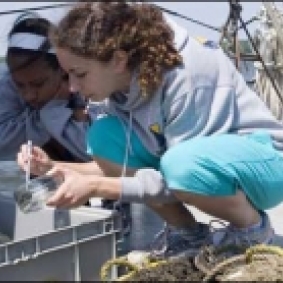Eight students will be presenting the summer work at the Ocean Sciences Meeting in March 2022!
Jennie M. Yuda, Lycoming College
Class Year:
2007Mentor:
Carys Mitchelmore, Ph.D.Project Title:
Dimethylsulfoniopropionate (DMSP) Levels and Function in Algal Symbiodinium sp. Isolated From Cnidarians
Abstract:
Dimethylsulfoniopropionate (DMSP) is the precursor of DMS, which plays significant roles in the global sulfur cycle (Steinke et al., 2000). Dinoflagellates are among the highest producers of DMSP; this is of importance in coral-algal symbiotic relationships. Various coral species have been shown to contain DMSP, produced by their resident symbiotic dinoflagellates (Symbiodinium sp.) and under stressed conditions display the recognizable odor of DMS. DMS is formed from DMSP via the action of the enzyme DMSP lyase, which some, but not all algae contain. Although corals have been shown to contain DMSP, no investigations have been directed at determining its role and function within these organisms. Various roles and functions of DMSP, including as an osmolyte, anti-grazing chemical, nitrogen storage molecule and an antioxidant have all been proposed in other algal species. Given the pivitol role of elevated levels of oxidative stress preceeding bleaching, our focus was to determine the role and function of DMSP as an antioxidant. DMSP's breakdown products, DMS, acrylate and DMSO have been shown to be even more efficient antioxidants (Sunda et al., 2002) than DMSP or other coral antioxidants. It is currently unknown if the coral symbiotic algae (Symbiodinium sp.) contains DMSP lyase, which may allow for the production of these more efficient antioxidants. Current research is focused on determining baseline levels of DMSP in a variety of Symbiodinium sp. strains to investigate if some strains possess more antioxidant protection than others. These studies involved determining levels over an entire growth cycle, as DMSP is known to vary with growth cycle conditions in other species. We also investigated if Symbiodinium sp. contain the enzyme DMSP lyase. Our research demonstrated that levels of DMSP varied with Symbiodinium sp. strains; in all strains maximal levels were seen during the exponential growth phase at Day 14. Symbiodinium algal strain 830 with antibiotic addition displayed DMSP lyase activity similar to findings of Steinke et al. (2000). Future work will focus on DMSP lyase host involvement employing the tropical sea anemone, Aiptasia sp.
Location:
Chesapeake Biological LaboratoryPresentations:
Mitchelmore, C. L., D. M. Yost, and J. M. Yuda*. 2008. DMSP & DMSP lyase levels in the coral algal symbionts, Symbiodinium sp. ASLO Ocean Sciences Meeting, Orlando, Florida .





